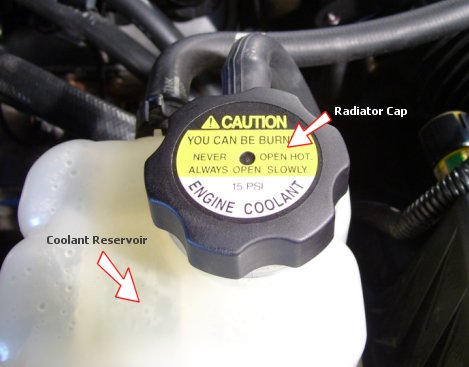fins. Without coolant, your engine will over heat and if left unattended severe engine damage will occur. Coolant colors can vary from green, orange, blue and yellow each having their own protective properties. Coolant leaks are common car problems; we have listed some of the most common causes below.

Red and Green Engine Coolant
Troubleshooting Procedure
Inspect the engine coolant level in the coolant reservoir tank; coolant level should be between the hot and cold marks. If the reservoir is empty the cooling system may have a leak. Always check the coolant level when the vehicle is cold, preferably over night.
USE CAUTION WHEN CHECK YOUR COOLANT LEVEL, ONLY CHECK LEVEL IN RADIATOR WHEN THE ENGINE IS COLD

Radiator Cap and Coolant Reservoir
A. Checking Water Pump. The water pump is used on the engine to circulate coolant from the engine to the radiator. The water pump is powered by the engine using a multi-ribbed belt or in some cases the engines timing belt. The main shaft in the water pump is used the support the drive pulley and the impeller. This pump shaft is supported by two bearings and sealed by a shaft seal. If the seal or bearings fail it causes coolant to leak from the inspection port in the water pump. The water pump must be removed and replace with a new unit. Replacement instruction varies from car to car for exact instruction consult an auto repair manual.
B. Check for Radiator Leaks. The radiator is used to remove the heat created by the engine from the coolant. Air is forced through radiator cooling fins either by car motion or by the cooling fan. This cooling fan can either be driven by the engine or an electric motor. Radiators are made from an aluminum core and two plastic tanks on either side. As a radiator ages the plastic tank will crack causing coolant to leak. To inspect for this condition use a flashlight to locate the radiator tanks. Inspect these tanks and the seal between the tank and the radiator core. If leakage is observed remove car radiator to replace with a new unit, refill with coolant and recheck the system.

Radiator Coolant Leak
C. Inspect Coolant Hoses. Rubber hoses are used to transfer coolant from one part of the engine to an accessory like a heater core or the radiator. To inspect hoses for leakage start with the engine cold, check hoses for cracks, bulging or oil contamination. If a hose is discovered that exhibits any of these conditions replace the hose with a new unit. When repairs have been completed refill the cooling system and recheck. A cooling system service or flush will keep your vehicle's cooling system from becoming acidic. This condition occurs when chemicals in the coolant break down creating acid. This acid is very corrosive and will destroy cooling system components. Flush regularly and replace thermostat and refill system with manufacturers recommend coolant/anti-freeze.

Coolant Chemical Breakdown
To avoid this problem simply change your coolant more often than the recommended 100,000 miles. Change your coolant every 40,000 miles and you should be ok. All engine coolants must be replaced on a normal schedule to avoid the coolant changing its chemical base composition to an acid. This condition will cause the coolant to eat away at internal engine parts, seals and gaskets, causing premature engine failure and added expense. The coolant mixture to water should be about 60% coolant and 40% water (distilled is recommended). Always add and check coolant level in the coolant reservoir when the vehicle is cold. Be careful of harsh chemical flushes because they can cause more damage than good, especially to aluminum heads, intake manifolds, and the engine block, read the warning carefully on the label.



























No comments:
Post a Comment